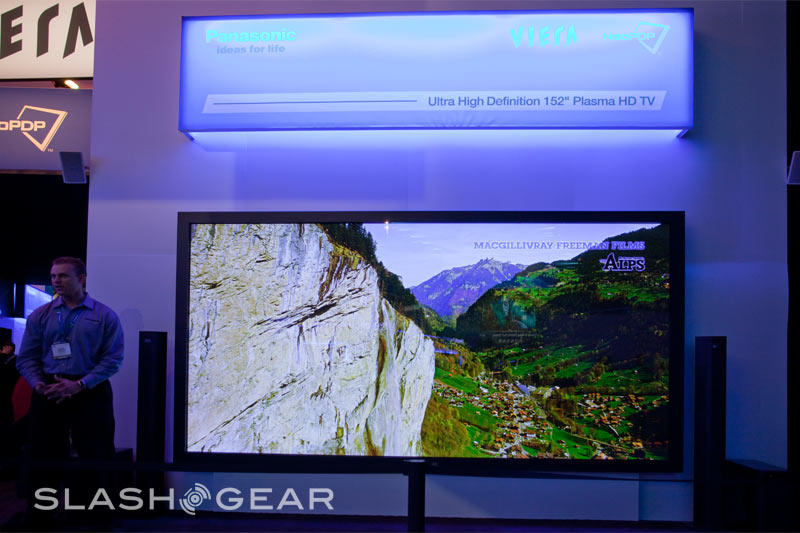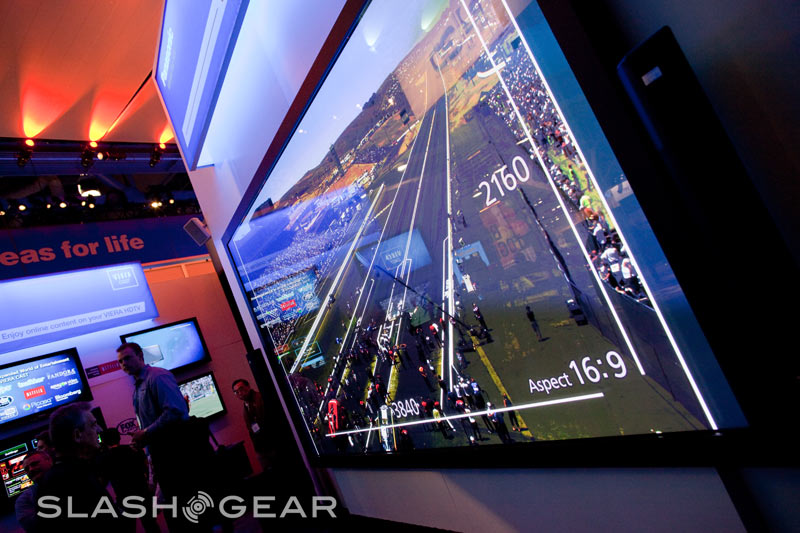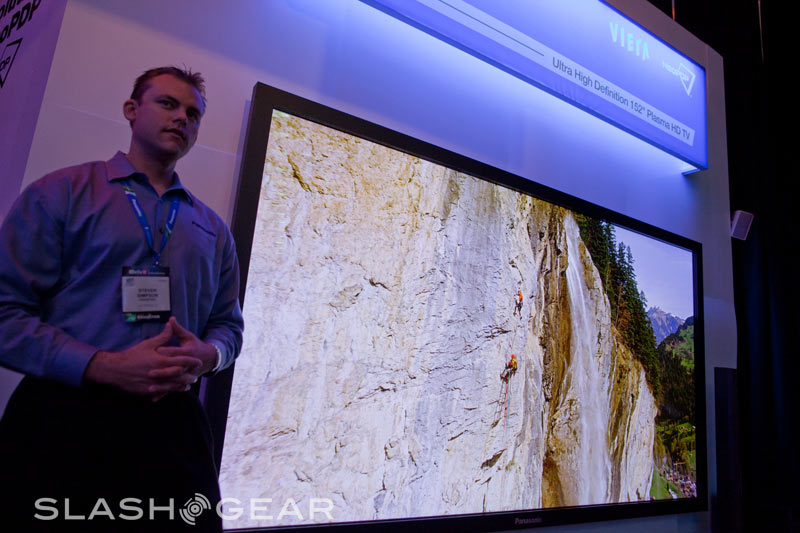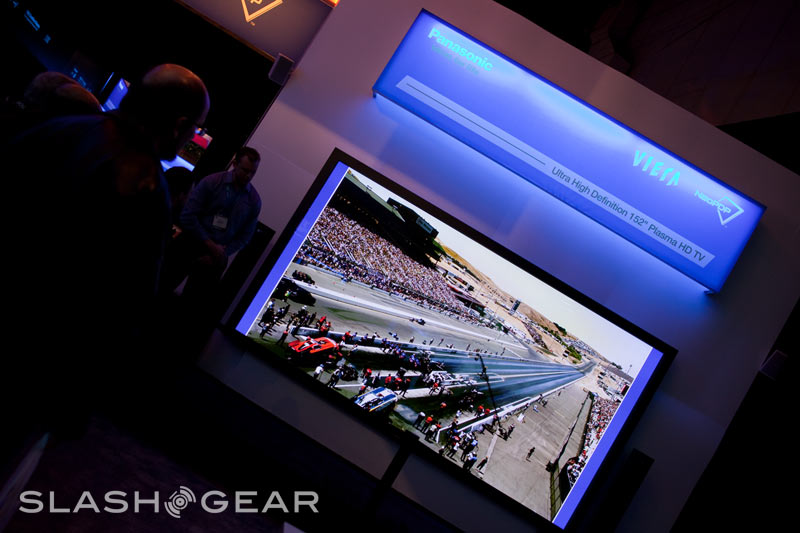Panasonic 152-Inch 4K2K Plasma HDTV
Consider knocking down a non-load-bearing wall (though maybe remortgage your house first): Panasonic have brought an "ultra-large" 152-inch plasma HDTV to CES 2010. The display isn't just special because of its whopping 4K x 2K resolution but because it'll also show Full HD 3D as long as you're wearing the proper glasses. We stopped by Panasonic's booth to check the monster out.
Panasonic helpfully supplied the man on the left for size-comparison purposes (and also to make sure we didn't drop the HDTV into our bag and make a run for the exit), and the good news is that picture quality is, like the scale, jaw-dropping. As for the 3D system, that uses a new frame-at-a-time image switching technology (rather than line-at-a-time) which, they say, makes for reduced crosstalk reduction and less double-image blurring.
Unsurprisingly there's no price tag attached to the 4,096 x 2,160 display, but Panasonic are positioning the unnamed HDTV – or at least its smaller brethren – as not only suited for home entertainment but in business, medical, education and commercial settings. We're just not sure we have enough space to push out couch back to accommodate it.
Press Release:
PANASONIC DEVELOPS WORLD'S LARGEST 152-INCH FULL HD 3D PLASMA DISPLAYThe ultra-large, 4K x 2K quadruple full HD plasma panel creates a true full HD 3D world, delivering an overwhelming immersive experience
LAS VEGAS, NV (January 6, 2010) – Panasonic Corporation, a world leader in the HDTV technology, has developed the world's largest1) 152-inch 4K x 2K definition Full HD 3D plasma display. The display features a revolutionary new plasma display panel (PDP) Panasonic developed with its new super-efficient quadruple luminous efficiency technology2). The technology enhances PDP's unique advantages as self-illuminating device, contributing to delivering an overwhelming immersive experience to viewers. The Panasonic 152-inch Full HD 3D PDP creates a true Full HD 3D world by faithfully reproducing 3D content such as Hollywood 3D movie titles11).
Self-illuminating plasma panels offer excellent response to moving images with full movition picture resolution3), making them suitable for rapid 3D image display. By employing the newly-developed ultra high-speed 3D drive technology, which adopts the super-efficient quadruple luminous efficiency technology, the new panel achieves a higher illuminating speed, about one fourth the speed of conventional Full HD panels4). This technology enables high-quality Full HD 3D display on the ultra large 152-inch 4K x 2K (4,096 x 2,160 pixels) panel.
The panel also incorporates a crosstalk reduction technology, essential for producing clear 3D images. Compared to other display technologies that use line-at-a-time driving method5), PDPs use frame-at-a-time driving method6) that gives PDP TVs an advantage in crosstalk reduction in principle. Panasonic has successfully developed a unique technology to minimize double-image that occurs when left- and right-eye images are switched alternately. The development has resulted in the 3D compatible plasma display that can render clear and smooth high-quality pictures by accurately reproducing video sources.
The ultra-large 152-inch Full HD 3D PDP, which delivers true 3D movie-theater experience, follows the development of the industry's first 103-inch Class size Full HD 3D PDP Panasonic introduced in 20087) and the home theater size 50-inch Class Full HD 3D PDP in 20098).
This year, which is really the first year of 3D Television, 3D TVs are expected to accelerate the growth of the flat-panel television market by providing new values to customers.
Television has evolved over the years through technological innovations. It started as a device to produce images to be simply watched and then it became a tool when connectivity with other AV devices is added. Now, with the 3D technology, it has developed into a device that delivers an immersive viewing experience, moving into literally an era of "next dimension."
Panasonic launches its first Full HD 3D TVs in 2010 with PDP technology, which is highly suitable for 3D TVs, to offer the utmost picture quality. Panasonic's new 3D TVs will deliver a true full HD 3D quality to create new and exciting television experiences.
Because 3D plasma displays can reproduce highly realistic images, they are considered ideal not only for home theater use but also for a wide variety of uses such as business, medical, education and commercial applications.
Panasonic will make the First Year of 3D Television as a springboard to boost its popularity, capitalizing on the company's ability to offer complete end-to-end solutions from professional 3D camcorders and Blu-ray Disc authoring service to consumer use 3D TVs and displays and 3D-enabled Blu-ray Disc players.
Furthermore, Panasonic strives to accelerate the spread of 3D products and drive growth in the the flat-panel television market, focusing on the development of a 3D infrastructure including 3D content through increased cooperation with Hollywood studios and broadcasters. The company hopes to contribute to the enhancement of 3D related business and the development of a new industry, which may be called 3D economic system that can be brought about through interactions among the related businesses.
For more information on Panasonic's Full HD 3D Technology, visit www.panasonic.com/3D.
1. Newly developed ultra high-speed 3D drive technology enables 3D display on ultra-large (152-inch), super high resolution (4K x 2K) panels
Using the super-efficient quadruple luminous efficiency technology, Panasonic developed 3D ultra high-speed drive technology. Compared to the conventional full HD panels4), the technology allows the new panel to achieve the same brilliance at about one-fourth speed. The new 152-inch panel also uses a new technology that enables even and stable discharge. Thanks to this discharge technology, the new panel can provide full HD images for left and right eyes formed with twice the volume of information as regular full HD images across the vast expanse of the screen equivalent to nine 50-inch panels with super high resolution (4,096 x 2,160) – four times the full HD (1,920 x 1,080) specification – while maintaining the brightness.
The new advanced PDP delivers high-quality 3D images, with virtually infinite 5,000,000:19 contrast ratio, accurate color reproduction and subtle gradation tones, on the ultra-large screen. With characters in the screen approach the viewers in life size, the new panel creates an overwhelmingly immersive experience.
2. Cross-talk reduction enables clear, high-definition 3D images
Because displaying 3D images involves alternate displays of left- and right-eye images, reducing the overlap (cross-talk) between these images is essential for high-quality 3D images. Unlike 3D LCD panels that use line by line scanning method, PDPs use frame-sequential method that displays images frame by frame very quickly, giving PDPs a tremendous advantage in crosstalk reduction. Incorporating newly-developed phosphors with short luminescence decay time – one third the time of conventional phosphors4) – as well as illumination control technology, the cross-talk reduction technology has succeeded in minimizing double images.
Enhancing the video reproduction capability of PDP, which has full moving picture resolution, the technology enables crisp and clear, high-quality 3D images by faithfully reproducing video sources.
3. Full HD x 2 frame sequential method
To reproduce 3D images, the new PDP uses the full HD x 2 frame10) sequential method that displays time sequential images, alternately reproducing discrete full HD (1920 x 1080 pixels) images for the left and right eyes on the display frame by frame. By adopting the method which is used in showing Hollywood 3D films in theaters, the new panel accurately reproduces high-quality 3D images in the living room.
Notes:
1) As of January 7, 2010; research by Panasonic
2) Comparison with the brightness of Panasonic's 2007 full HD panels at the same power level.
3) Moving picture resolution indicates the motion display performance by number of lines which human eyes can recognize. (Measured by Advanced PDP Development Center Corporation Method). Full moving picture resolution has 1080 lines.
4) Compared with the brightness of Panasonic's 2009 full HD panels.
5) A method to produce images by illuminating one line of the frame at a time.
6) A method to produce images by illuminating all lines of the frame at a time.
7) Announced by Panasonic on September 24, 2008.
8) Announced by Panasonic on September 28, 2009.
9) Contrast of dark areas that can be simultaneously displayed on the screen.
10) A unit of pictures in a video signal. In digital high-definition broadcasts in Japan, 30 frames are transmitted per second.
11) Current 3D content will be limited and may include certain Blu-ray Disc titles and satellite programming. Additional equipment and/or subscription fees may apply. 3D Blu-ray Disc player and discs sold separately. 3D Eyewear required for viewing. One pair included with purchase.




